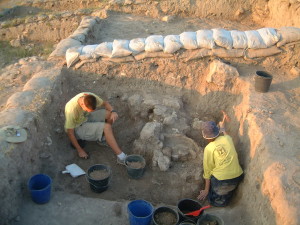

4 And there went out a champion out of the camp of the Philistines, named Goliath, of Gath, whose height was six cubits and a span.
Researchers Unearth Historical Findings at Gath, the Ancient Hometown of Goliath

TELL ES-SAFI, Israel – A large archaeological team is currently in the middle of a month-long project to excavate and study the remains of Gath, the ancient hometown of one of the Bible’s most famous villains: Goliath.
Since the last day of June, an international team of archaeologists has been carefully studying Tell es-Safi, a historic civilization site located halfway between Jerusalem and Ashkelon. The excavations are directed by Dr. Aren Maeir, a professor at Israel’s Bar-Ilan University who has spent over 15 years studying the ancient settlement.
Many historians and archaeologists believe the Tell es-Safi site is where the ancient Philistine city of Gath was located. Though experts are quick to point out that no “incontrovertible proof” of Tell es-Safi’s identity has been discovered, it is still the general consensus among most scholars, and the location is now commonly referred to as “Tell es-Safi/Gath.”
“Although there once was a bit of a controversy regarding the exact location of Gath,” the Tell es-Safi/Gath Excavation’s blog explains, “based on present evidence, most scholars believe that it was located at the site known as Tell es-Safi. The tell, which is situated approximately halfway between Jerusalem and Ashkelon, is one of the largest biblical sites in Israel. Settled continuously from the Chalcolithic period (5th mill. BCE) until modern times, it is a veritable mine of archaeological evidence from all periods.”
In the Bible, Gath is mentioned a number of times in the Old Testament, most notably as the hometown of the famous giant Goliath (1st Samuel 17). However, Gath is also described in the Scriptures as an important Philistine city (Joshua 13:3), a place where David took refuge (1st Samuel 21:10), and a temporary home for the Ark of the Covenant (1st Samuel 5:8).
Over the years, members of Dr. Maier’s excavation team have found many historical relics, such as an ancient, man-made trench most likely used for siege purposes. In 1998, hundreds of pottery vessels from shortly after the time of David and Solomon were discovered, which strongly confirmed the Biblical narratives found in the books of 1st and 2nd Kings.
“Recently, some scholars have questioned the veracity of the description of the events in this period as portrayed in the Bible,” an article on the excavation team’s blog reads. “Accordingly, it is claimed that there is little if any non-biblical archaeological and historical evidence to that relates to this period. But in light of the extraordinarily rich finds that were discovered at Tall es-Safi/Gath, it would appear that at least from an archaeological point of view, this period is in fact well represented at this site.”
In 2005, archaeologists at the site unearthed an ancient inscription from around the time of David that mentions two Philistine names reminiscent of the original form of the name “Goliath.” Three years later, remarkably preserved remnants of the “lower city” portion of Gath were discovered.
However, several findings this year shed light on Gath’s destruction in the late 9th century B.C. by Syrian’s King Hazael, as described in 2nd Kings 12:17. Remains of siege fortifications have been uncovered, as well as plentiful evidence of a destructive fire most likely brought upon the city by Hazael. In addition, there are several indications that a powerful earthquake once struck the area, potentially the same one that is mentioned in Amos 1:1.
Ultimately, although Dr. Maeir is personally hesitant to call the Bible “an infallible text,” he recognizes that the Scriptures are an invaluable tool for their excavation studies, and has said that it would be “ludicrous” to not use the Bible as a reference.
“We’re here not to prove or disprove the Bible,” he told The Chronicle of Higher Education. “We’re here to illustrate the cultures in which the biblical text was formed.”
Horned Philistine Altar Discovered at Gath
Bible and archaeology news

Archaeologists excavating at the Philistine site of Tell es-Safi/Gath in Israel's southern coastal plain have discovered a rare horned altar dating to the ninth century B.C.E. The stone altar, which stands more than 3 feet tall, is the earliest ever found in Philistia.
Archaeologists excavating at the Philistine site of Tell es-Safi/Gath in Israel’s southern coastal plain have discovered a rare horned altar dating to the ninth century B.C.E. The stone altar, which stands more than 3 feet tall, is the earliest ever found in Philistia.The top of the altar was outfitted with a pair of horns, a feature reminiscent of ancient Israelite altars described in the Hebrew Bible (Exodus 27:1–2; 1 Kings 1:50) and, more rarely, found in archaeological contexts.* But while Israelite altars have four horns, the Philistine altar found at Gath only has two.
“The altar is a small, but an impressive and special window into the Philistine and Israelite cultures of the time in general, and their rituals in particular,” said Aren Maeir, director of the Tell es-Safi/Gath excavations. “It’s not every day we find items from Biblical times so closely related to items described in the Biblical text.”
Very useful information
ReplyDeleteyou can also check on my blog divinityhistoryalevel.blogspot.com